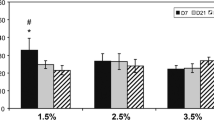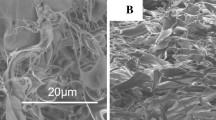Abstract
Introduction
Cell-based therapies for regeneration of the degenerated intervertebral disc (IVD) are an alternative to current surgical intervention. Mesenchymal stem cells (MSCs), in combination with a scaffold, might be ideal candidates for regenerating nucleus pulposus (NP), the pressure-distributing part of the IVD. While the use of growth factors for MSCs differentiation currently receives major attention, in this study we compare the performance of sponge-like matrixes in supporting cell differentiation into NP-like cells.
Materials and methods
Four types matrixes approved as medical devices for other applications were tested as scaffolds for MSCs: two made of equine or porcine collagen, one of gelatin and one of chitosan. Bone marrow-derived human MSCs were seeded in these scaffolds or embedded in alginate, as a three-dimensional control. After five weeks in culture, NP-like differentiation of the cell-scaffold constructs was analyzed by qRT-PCR, histology, total DNA quantification, proteoglycan accumulation and immunohistochemistry.
Results
MSCs in collagen matrixes and gelatin produced more mRNA and proteins of the chondrogenic markers collagen type I, collagen type II (COL2) and aggrecan (ACAN), when compared with cells embedded in alginate or chitosan. Proteoglycan accumulation and cell survival were also higher in collagen and gelatin matrixes. Gene expression results were also confirmed by histological and immunohistochemical staining. In contrast to alginate control, the gene expression of the undesired bone marker osteopontin was lower in all tested groups. In porcine collagen supports, MSC expression ratio between COL2/ACAN closely resembled the expression of nucleus pulposus cells, but gene expression of recently described NP markers keratin19, PAX1 and FOXF1 was lower.
Conclusions
Collagen supports provide a readily available, medically approved and effective scaffold for chondrogenic differentiation in vitro, but the phenotype of differentiated MSCs is not yet completely equivalent to that of NP cells.







Similar content being viewed by others
References
Richardson SM, Mobasheri A, Freemont AJ, Hoyland JA (2007) Intervertebral disc biology, degeneration and novel tissue engineering and regenerative medicine therapies. Histol Histopathol 22:1033–1041
Sive JI, Baird P, Jeziorsk M, Watkins A, Hoyland JA, Freemont AJ (2002) Expression of chondrocyte markers by cells of normal and degenerate intervertebral discs. Mol Pathol 55:91–97
Mwale F, Roughley P, Antoniou J (2004) Distinction between the extracellular matrix of the nucleus pulposus and hyaline cartilage: a requisite for tissue engineering of intervertebral disc. Eur Cell Mater 8:58–63 (discussion 63–64, vol008a06 [pii])
Zhang Y, Sun Z, Liu J, Guo X (2008) Advances in susceptibility genetics of intervertebral degenerative disc disease. Int J Biol Sci 4:283–290
Pye SR, Reid DM, Adams JE, Silman AJ, O’Neill TW (2007) Influence of weight, body mass index and lifestyle factors on radiographic features of lumbar disc degeneration. Ann Rheum Dis 66:426–427. doi:10.1136/ard.2006.057166
Sobajima S, Kim JS, Gilbertson LG, Kang JD (2004) Gene therapy for degenerative disc disease. Gene Ther 11:390–401. doi:10.1038/sj.gt.3302200
Sobajima S, Vadala G, Shimer A, Kim JS, Gilbertson LG, Kang JD (2008) Feasibility of a stem cell therapy for intervertebral disc degeneration. Spine J 8:888–896. doi:10.1016/j.spinee.2007.09.011
Meisel HJ, Siodla V, Ganey T, Minkus Y, Hutton WC, Alasevic OJ (2007) Clinical experience in cell-based therapeutics: disc chondrocyte transplantation A treatment for degenerated or damaged intervertebral disc. Biomol Eng 24:5–21. doi:10.1016/j.bioeng.2006.07.002
Maroudas A, Stockwell RA, Nachemson A, Urban J (1975) Factors involved in the nutrition of the human lumbar intervertebral disc: cellularity and diffusion of glucose in vitro. J Anat 120:113–130
Baksh D, Song L, Tuan RS (2004) Adult mesenchymal stem cells: characterization, differentiation, and application in cell and gene therapy. J Cell Mol Med 8:301–316. pii: 008.003.03
Colter DC, Sekiya I, Prockop DJ (2001) Identification of a subpopulation of rapidly self-renewing and multipotential adult stem cells in colonies of human marrow stromal cells. Proc Natl Acad Sci USA 98:7841–7845. doi:10.1073/pnas.141221698
Jiang Y, Jahagirdar BN, Reinhardt RL, Schwartz RE, Keene CD, Ortiz-Gonzalez XR, Reyes M, Lenvik T, Lund T, Blackstad M, Du J, Aldrich S, Lisberg A, Low WC, Largaespada DA, Verfaillie CM (2002) Pluripotency of mesenchymal stem cells derived from adult marrow. Nature 418:41–49. doi:10.1038/nature00870
Pittenger MF, Mackay AM, Beck SC, Jaiswal RK, Douglas R, Mosca JD, Moorman MA, Simonetti DW, Craig S, Marshak DR (1999) Multilineage potential of adult human mesenchymal stem cells. Science 284:143–147
Calvert JW, Marra KG, Cook L, Kumta PN, DiMilla PA, Weiss LE (2000) Characterization of osteoblast-like behavior of cultured bone marrow stromal cells on various polymer surfaces. J Biomed Mater Res 52:279–284. doi:10.1002/1097-4636(200011)52:2<279:AID-JBM6>3.0.CO;2-8
Yoo JU, Barthel TS, Nishimura K, Solchaga L, Caplan AI, Goldberg VM, Johnstone B (1998) The chondrogenic potential of human bone-marrow-derived mesenchymal progenitor cells. J Bone Joint Surg Am 80:1745–1757
Bonab MM, Alimoghaddam K, Talebian F, Ghaffari SH, Ghavamzadeh A, Nikbin B (2006) Aging of mesenchymal stem cell in vitro. BMC Cell Biol 7:14. doi:10.1186/1471-2121-7-14
van den Bogaerdt AJ, van der Veen VC, van Zuijlen PP, Reijnen L, Verkerk M, Bank RA, Middelkoop E, Ulrich MM (2009) Collagen cross-linking by adipose-derived mesenchymal stromal cells and scar-derived mesenchymal cells: Are mesenchymal stromal cells involved in scar formation? Wound Repair Regen 17:548–558. doi:10.1111/j.1524-475X.2009.00501.x
Barry F, Boynton RE, Liu B, Murphy JM (2001) Chondrogenic differentiation of mesenchymal stem cells from bone marrow: differentiation-dependent gene expression of matrix components. Exp Cell Res 268:189–200. doi:10.1006/excr.2001.5278
Shen B, Wei A, Tao H, Diwan AD, Ma DD (2009) BMP-2 enhances TGF-beta3-mediated chondrogenic differentiation of human bone marrow multipotent mesenchymal stromal cells in alginate bead culture. Tissue Eng Part A 15:1311–1320. doi:10.1089/ten.tea.2008.0132
Miljkovic ND, Cooper GM, Marra KG (2008) Chondrogenesis, bone morphogenetic protein-4 and mesenchymal stem cells. Osteoarthritis Cartilage 16:1121–1130. doi:10.1016/j.joca.2008.03.003
Cook SD, Patron LP, Salkeld SL, Rueger DC (2003) Repair of articular cartilage defects with osteogenic protein-1 (BMP-7) in dogs. J Bone Joint Surg Am 85-A(Suppl 3):116–123
Feng G, Wan Y, Balian G, Laurencin CT, Li X (2008) Adenovirus-mediated expression of growth and differentiation factor-5 promotes chondrogenesis of adipose stem cells. Growth Factors 26:132–142. doi:10.1080/08977190802105917
Huang CY, Reuben PM, D’Ippolito G, Schiller PC, Cheung HS (2004) Chondrogenesis of human bone marrow-derived mesenchymal stem cells in agarose culture. Anat Rec A Discov Mol Cell Evol Biol 278:428–436. doi:10.1002/ar.a.20010
Diduch DR, Jordan LC, Mierisch CM, Balian G (2000) Marrow stromal cells embedded in alginate for repair of osteochondral defects. Arthroscopy 16:571–577. doi:10.1053/jars.2000.4827
Ma HL, Hung SC, Lin SY, Chen YL, Lo WH (2003) Chondrogenesis of human mesenchymal stem cells encapsulated in alginate beads. J Biomed Mater Res A 64:273–281. doi:10.1002/jbm.a.10370
Gaetani P, Torre ML, Klinger M, Faustini M, Crovato F, Bucco M, Marazzi M, Chlapanidas T, Levi D, Tancioni F, Vigo D, Rodriguez y Baena R (2008) Adipose-derived stem cell therapy for intervertebral disc regeneration: an in vitro reconstructed tissue in alginate capsules. Tissue Eng Part A 14:1415–1423. doi:10.1089/ten.tea.2007.0330
Seguin CA, Grynpas MD, Pilliar RM, Waldman SD, Kandel RA (2004) Tissue engineered nucleus pulposus tissue formed on a porous calcium polyphosphate substrate. Spine (Phila Pa 1976) 29:1299–1306.doi:00007632-200406150-00005 (discussion 1306–1307)
Martin I, Shastri VP, Padera RF, Yang J, Mackay AJ, Langer R, Vunjak-Novakovic G, Freed LE (2001) Selective differentiation of mammalian bone marrow stromal cells cultured on three-dimensional polymer foams. J Biomed Mater Res 55:229–235. doi:10.1002/1097-4636(200105)55:2<229:AID-JBM1009>3.0.CO;2-Q
Wang Y, Kim UJ, Blasioli DJ, Kim HJ, Kaplan DL (2005) In vitro cartilage tissue engineering with 3D porous aqueous-derived silk scaffolds and mesenchymal stem cells. Biomaterials 26:7082–7094. doi:10.1016/j.biomaterials.2005.05.022
Alini M, Li W, Markovic P, Aebi M, Spiro RC, Roughley PJ (2003) The potential and limitations of a cell-seeded collagen/hyaluronan scaffold to engineer an intervertebral disc-like matrix. Spine (Phila Pa 1976) 28:446–454. doi:10.1097/01.BRS.0000048672.34459.31 (discussion 453)
Richardson SM, Hughes N, Hunt JA, Freemont AJ, Hoyland JA (2008) Human mesenchymal stem cell differentiation to NP-like cells in chitosan-glycerophosphate hydrogels. Biomaterials 29:85–93. doi:10.1016/j.biomaterials.2007.09.018
Ponticiello MS, Schinagl RM, Kadiyala S, Barry FP (2000) Gelatin-based resorbable sponge as a carrier matrix for human mesenchymal stem cells in cartilage regeneration therapy. J Biomed Mater Res 52:246–255. doi:10.1002/1097-4636(200011)52:2<246:AID-JBM2>3.0.CO;2-W
Bjornsson S (1993) Simultaneous preparation and quantitation of proteoglycans by precipitation with alcian blue. Anal Biochem 210:282–291. doi:10.1006/abio.1993.1197
Dominici M, Le Blanc K, Mueller I, Slaper-Cortenbach I, Marini F, Krause D, Deans R, Keating A, Prockop D, Horwitz E (2006) Minimal criteria for defining multipotent mesenchymal stromal cells. The International Society for Cellular Therapy position statement. Cytotherapy 8:315–317. doi:10.1080/14653240600855905
Minogue BM, Richardson SM, Zeef LA, Freemont AJ, Hoyland JA (2010) Characterisation of the human nucleus pulposus cell phenotype and evaluation of novel marker gene expression to define adult stem cell differentiation. Arthritis Rheum 62(12):3695–3705 (10.1002/art.27710)
Rutges J, Creemers LB, Dhert W, Milz S, Sakai D, Mochida J, Alini M, Grad S (2010) Variations in gene and protein expression in human nucleus pulposus in comparison with annulus fibrosus and cartilage cells: potential associations with aging and degeneration. Osteoarthritis Cartilage 18:416–423. doi:10.1016/j.joca.2009.09.009
Fragonas E, Valente M, Pozzi-Mucelli M, Toffanin R, Rizzo R, Silvestri F, Vittur F (2000) Articular cartilage repair in rabbits by using suspensions of allogenic chondrocytes in alginate. Biomaterials 21:795–801. pii: S0142961299002410
Hunziker EB (2002) Articular cartilage repair: basic science and clinical progress A review of the current status and prospects. Osteoarthritis Cartilage 10:432–463. doi:10.1053/joca.2002.0801
Richardson SM, Hoyland JA (2008) Stem cell regeneration of degenerated intervertebral discs: current status. Curr Pain Headache Rep 12:83–88
Athanasiou KA, Niederauer GG, Agrawal CM (1996) Sterilization, toxicity, biocompatibility and clinical applications of polylactic acid/polyglycolic acid copolymers. Biomaterials 17:93–102. pii: 0142961296857541
Hall BK (1987) Earliest evidence of cartilage and bone development in embryonic life. Clin Orthop Relat Res 255–272
Acknowledgments
This work was supported by the Swiss Paraplegic Foundation. We thank Mr. Beat Haenni, from the Institute of Anatomy of Bern, for technical assistance with scanning electron microscopy.
Conflict of interest
None.
Author information
Authors and Affiliations
Corresponding author
Rights and permissions
About this article
Cite this article
Bertolo, A., Mehr, M., Aebli, N. et al. Influence of different commercial scaffolds on the in vitro differentiation of human mesenchymal stem cells to nucleus pulposus-like cells. Eur Spine J 21 (Suppl 6), 826–838 (2012). https://doi.org/10.1007/s00586-011-1975-3
Received:
Accepted:
Published:
Issue Date:
DOI: https://doi.org/10.1007/s00586-011-1975-3




